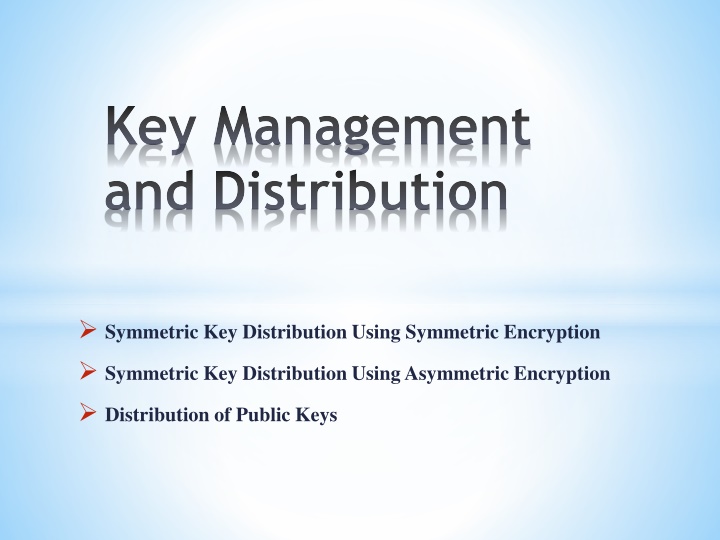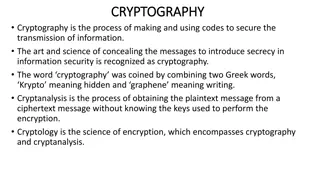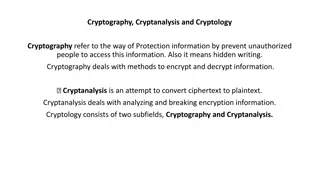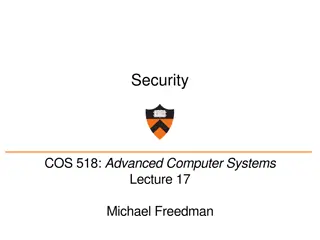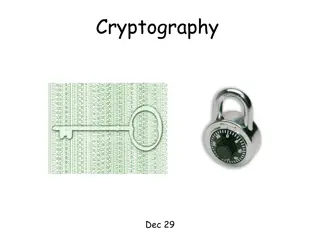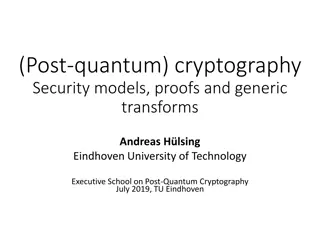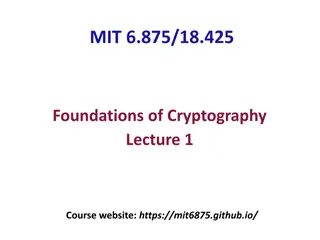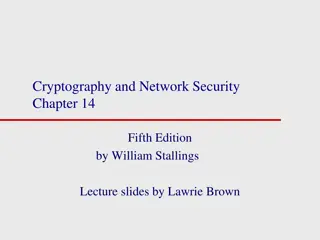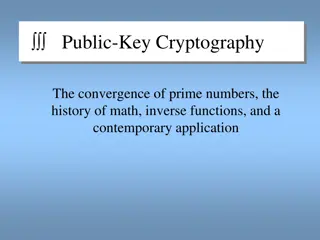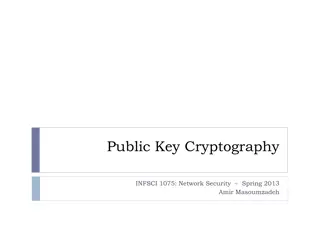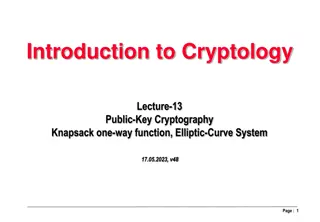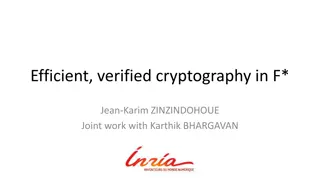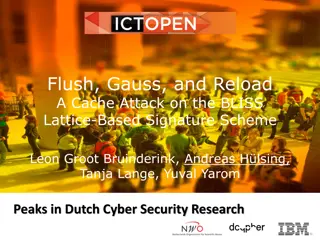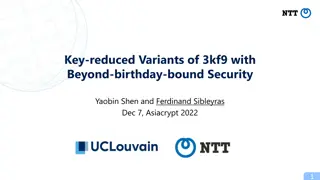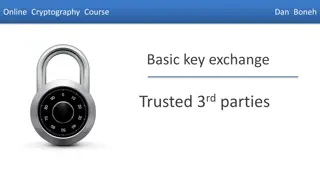Key Management and Distribution Techniques in Cryptography
In the realm of cryptography, effective key management and distribution are crucial for secure data exchange. This involves methods such as symmetric key distribution using symmetric or asymmetric encryption, as well as the distribution of public keys. The process typically includes establishing unique master keys, key distribution centers, and secure session key exchange between communicating parties. The strategic distribution of keys helps in safeguarding data and ensuring the integrity of cryptographic systems.
Download Presentation

Please find below an Image/Link to download the presentation.
The content on the website is provided AS IS for your information and personal use only. It may not be sold, licensed, or shared on other websites without obtaining consent from the author.If you encounter any issues during the download, it is possible that the publisher has removed the file from their server.
You are allowed to download the files provided on this website for personal or commercial use, subject to the condition that they are used lawfully. All files are the property of their respective owners.
The content on the website is provided AS IS for your information and personal use only. It may not be sold, licensed, or shared on other websites without obtaining consent from the author.
E N D
Presentation Transcript
Key Management and Distribution Symmetric Key Distribution Using Symmetric Encryption Symmetric Key Distribution Using Asymmetric Encryption Distribution of Public Keys
Symmetric Key Distribution Using Symmetric Encryption For symmetric encryption to work, the two parties to an exchange must share the same key. That key must be protected from access by others. Furthermore, frequent key changes are usually desirable to limit the amount of data compromised if an attacker learns the key. Therefore, the strength of any cryptographic system rests with the key distribution technique, A term that refers to the means of delivering a key to two parties who wish to exchange data without allowing others to see the key.
Key Distribution Scenario The key distribution concept deployed in a number of ways. A typical scenario is illustrated in Figure. The scenario assumes that each user shares a unique master key with distribution (KDC). can be the key center
Let us assume that user A wishes to establish a logical connection with B and requires a one-time session key to protect the data transmitted over the connection. Ahas a master key, Ka, known only to itself and the KDC. Similarly, B shares the master key Kbwith the KDC.
The following steps occur. 1. A issues a request to the KDC for a session key to protect a logical connection to B. The message includes the identity of A and B and a unique identifier, N1, for this transaction, which we refer to as a nonce. The nonce may be a timestamp, a counter, or a random number. The minimum requirement is that it differs with each request. It should be difficult for an opponent to guess the nonce. Thus, a random number is a good choice for a nonce.
2. The KDC responds with a message encrypted using Ka. Thus, A is the only one who can successfully read the message, and A knows that it originated at the KDC. The message includes two items intended forA: The one-time session key, Ks, to be used for the session The original request message, including the nonce, to enable A to match this response with the appropriate request. Thus, A can verify that its original request was not altered before reception by the KDC and, because of the nonce, that this is not a replay of some previous request.
In addition, the message includes two items intended for B: The one-time session key, Ks, to be used for the session. An identifier ofA(e.g., its network address), IDA These last two items are encrypted with Kb(the master key that the KDC shares with B). They are to be sent to B to establish the connection and proveA s identity.
3.A stores the session key for use in the upcoming session and forwards to B the information that originated at the KDC for B, namely, E(Kb,[Ks||IDA]). Because this information with Kb, it is protected from eavesdropping. B now knows the session key (Ks), knows that the other party is A (from IDA), and knows that originated at the KDC (because it is encrypted using Kb). is encrypted the information At this point, a session key has been securely delivered to Aand B, and they may begin their protected exchange.
However, steps are desirable: 4. Using the newly minted session key for encryption, B sends a nonce, N2, toA. two additional 5.Also, using Ks, A responds with f(N2), where f is a function that some transformation on N2 (e.g., adding one). performs These steps assure B that the original message it received (step 3) was not a replay. Note that the actual key distribution involves only steps 1 - 3, but that steps 4 and 5, as well as step 3, perform an authentication function.
Hierarchical Key Control For very large networks, it may not be practical to limit the key distribution function to a single KDC. As an alternative, a hierarchy of KDCs can be established. For example, there can be local KDCs, each responsible for a small domain of the overall internetwork, such as a single LAN or a single building. For communication among entities within the same local domain, the local KDC is responsible for key distribution.
If two entities in different domains desire a shared key, then the corresponding local KDCs can communicate through a global KDC. In this case, any one of the three KDCs involved can actually select the key. The hierarchical concept can be extended to three or even more layers, depending on the size of the user population and the geographic scope of the internetwork.
Symmetric Key Distribution Using Asymmetric Encryption Simple Secret Key Distribution An extremely simple scheme was put forward by Merkle and as illustrated in Figure. If A wishes to communicate with B, the following procedure is employed: 1. A generates a public/private key pair {PUa, PRa} and transmits a message to B consisting of PUaand an identifier ofA, IDA. 2. B generates a secret key, Ks, and transmits it to A, which is encrypted withA s public key.
3. A computes D(PRa, E(PUa, Ks)) to recover the secret key. Because only Acan decrypt the message, onlyAand B will know the identity of Ks. 4. Adiscards PUaand PRaand B discards PUa. A and B can now securely communicate using conventional encryption and the session key Ks. At the completion of the exchange, bothAand B discard Ks. Despite its simplicity, this is an attractive protocol. No keys exist before the start of the communication and none exist after the completion of communication. Thus, the risk of compromise of the keys is minimal. At the same time, the communication is secure from eavesdropping.
This protocol is insecure against an adversary who can intercept messages and then either relay the intercepted message or substitute another message. Such an attack is known as a man-in-the-middle attack. If an adversary, D, has control of the intervening communication channel, then D can compromise the communication in the following fashion without being detected: 1. A generates a public/private key pair {PUa, PRa} and transmits a message intended for B consisting of PUaand an identifier ofA, IDA. 2. D intercepts the message, creates its own public/private key pair {PUd, PRd} and transmits PUs||IDAto B.
3. B generates a secret key, Ks, and transmits E(PUs, Ks). 4. D intercepts the message and learns Ksby: D(PRd, E(PUd, Ks)). 5. D transmits E(PUa, Ks) toA.
The result is that both Aand B know Ksand are unaware that Kshas also been revealed to D. Aand B can now exchange messages using Ks. D no longer actively interferes with the communications channel but simply eavesdrops. Knowing Ks, D can decrypt all messages, and both A and B are unaware of the problem. Thus, this simple protocol is only useful in an environment where the only threat is eavesdropping
Secret Key Distribution with Confidentiality and Authentication The approach shown in the Figure provides protection against both active and passive attacks. We begin at a point when it is assumed that A and B have exchanged public keys by one of the described schemes.
Then the following steps occur. 1. A uses B s public key to encrypt a message to B containing an identifier of A(IDA) and a nonce (N1), which is used to identify this transaction uniquely. B sends a message to A encrypted with PUaand containing A s nonce (N1) as well as a new nonce generated by B (N2). Because only B could have decrypted message (1), the presence of N1in message (2) assures A that the correspondent is B. 2.
3. A returns N2, encrypted using B s public key, to assure B that its correspondent isA. 4. A selects a secret key Ksand sends M = E(PUb, E(PRa, Ks)) to B. Encryption of this message with B s public key ensures that only B can read it; encryption withA s private key ensures that onlyAcould have sent it. 5. B computes D(PUa, D(PRb, M)) to recover the secret key. The result is that this scheme ensures both confidentiality and authentication in the exchange of a secret key
Distribution Of Public Keys Several techniques have been proposed for the distribution of public keys. Virtually all these proposals can be grouped into the following general schemes: 1. Public announcement 2. Publicly available directory 3. Public-key authority 4. Public-key certificates
Public Announcement of Public Keys In a public-key encryption, any participant can send his or her public key to any other participant or broadcast the key to the community at large as shown in the figure. This approach has a major weakness: Anyone can forge such a public announcement. That is, some user could pretend to be user A and send a public key to another participant or broadcast such a public key. Until such time as user A discovers the forgery and alerts other participants, the forger is able to read all encrypted messages intended for A and can use the forged keys for authentication
PubliclyAvailable Directory A greater degree of security can be achieved by maintaining a publicly available dynamic directory of public keys. Maintenance and distribution of the public directory would have to be the responsibility of some trusted entity or organization. This scheme is clearly more secure than individual public announcements but still has vulnerabilities.
Public-Key Authority Stronger security for public-key distribution can be achieved by providing tighter control over the distribution of public keys from the directory. Atypical scenario is illustrated in the figure. As before, the scenario assumes that a central authority maintains a dynamic directory of public keys of all participants. In addition, each participant reliably knows a public key for the authority, with only corresponding private key. The following steps occur. the authority knowing the
1. A sends a timestamped message to the public-key authority containing a request for the current public key of B. 2. The authority responds with a message that is encrypted using the authority s private key, PRauth. Thus, A is able to decrypt the message using the authority s public key.
Therefore, A is assured that the message originated with the authority. The message includes the following: B s public key, PUb, whichAcan use to encrypt messages destined for B The original request used to enable A to match this response with the corresponding earlier request and to verify that the original request was not altered before reception by the authority The original timestamp given so A can determine that this is not an old message from the authority containing a key other than B s current public key
3. A stores Bs public key and also uses it to encrypt a message to B containing an identifier of A (IDA) and a nonce (N1), which is used to identify this transaction uniquely. 4, 5. B retrieves A s public key from the authority in the same manner as A retrieved B s public key.
However, two additional steps are desirable: 6. B sends a message to A encrypted with PUa and containing A s nonce (N1) as well as a new nonce generated by B (N2). Because only B could have decrypted message (3), the presence of N1in message (6) assures A that the correspondent is B. 7. A returns N2, which is encrypted using B s public key, to assure B that its correspondent isA.
